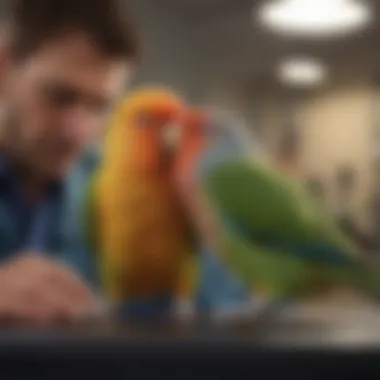Essential Lovebird Care: Habitat, Diet, and Health Tips


Intro
Caring for lovebirds involves understanding their unique needs and behaviors. These small, vibrant parrots require specific conditions to thrive as pets. This guide aims to provide insights into their care, offering practical advice for owners to foster a happy and healthy environment for their feathered companions. From habitat setup to diet, socialization, and health care, we will cover essential aspects that influence the well-being of lovebirds. Let's delve deeper into understanding these charming creatures.
Understanding Your Pet
Pet Behavior Basics
Lovebirds are social and intelligent birds. They thrive on interaction and can develop strong bonds with both their owners and other lovebirds. Their playful nature often manifests in various behaviors such as vocalizing, climbing, and playing with objects. It is crucial for owners to recognize signs of stress or boredom.
Common Breed Characteristics
There are several species of lovebirds, including the Peach-faced Lovebird, Fischer’s Lovebird, and Masked Lovebird. Each breed has its unique characteristics and color patterns. Understanding these distinctions can help owners cater to the specific preferences and needs of their lovebirds.
Species-Specific Needs
Lovebirds have particular requirements regarding social interaction, space, and diet. They need ample mental stimulation and social engagement to stay happy. Adequate cage size and toys are essential for their physical and mental well-being.
Pet Care and Maintenance
Feeding Guidelines
A balanced diet is crucial for lovebirds. They should primarily consume high-quality pellets specifically designed for them. Fresh fruits and vegetables should be incorporated into their diet, such as apples, carrots, and leafy greens. Avoid offering avocado or chocolate as they are toxic to birds.
Grooming Essentials
Regular grooming is important to prevent issues with feathers and skin. Owners should provide opportunities for their lovebirds to bathe. This can be done through shallow water bowls or mist spraying. Nail trimming may also be necessary occasionally, ensuring their comfort and mobility.
Hygiene Practices
Keeping the cage clean is vital for health. Owners must regularly remove old food, droppings, and debris from the cage. A weekly thorough cleaning is recommended, using bird-safe cleaning products to eliminate bacteria and odors.
Training and Development
Basic Commands and Skills
Training lovebirds enhances communication and strengthens the bond between the owner and the pet. Simple commands such as
Intro to Lovebirds
Understanding lovebirds is essential for anyone considering these charming pets. Their vibrant personalities and unique behaviors make them a popular choice among bird lovers. Lovebirds are affectionate, social creatures that thrive on interaction. This section aims to lay the foundation for responsible ownership by providing insights into their characteristics and species.
Understanding Lovebird Characteristics
Lovebirds are small parrots known for their playful demeanor and strong bonding tendencies. They display a range of behaviors that reflect their emotional needs. One notable trait is their desire for companionship, both with humans and other lovebirds. They often form deep attachments, demonstrated through preening and cuddling. Additionally, they are curious and enjoy exploring their surroundings. Understanding these traits is key to ensuring their happiness and health.
Effective socialization is also crucial. Lovebirds can become stressed if left alone for extended periods. They usually need daily interaction to feel secure. Furthermore, their vocalizations, which can be sweet or loud, reflect their moods. Knowing when your lovebird is comfortable or uneasy helps in establishing a positive environment.
Different Lovebird Species
There are several species of lovebirds, each with its own unique characteristics. The most common ones include the Peach-Faced Lovebird, Fischer's Lovebird, and Masked Lovebird.
- Peach-Faced Lovebird: Known for its beautiful colors ranging from light green to pastel shades, it is the most recognized species. These lovebirds are social and often seen engaging in playful antics.
- Fischer's Lovebird: This species features distinct yellow and green plumage. Fischer's are lively and enjoy interaction with both humans and other lovebirds.
- Masked Lovebird: These birds are characterized by their darker masks and vibrant bodies. They are known for their affectionate nature and tend to form strong bonds with their owners.


It is essential to research the specific needs and behaviors of each species. This knowledge aids in selecting the right lovebird for your lifestyle, ensuring a fulfilling experience for both the owner and the bird.
Setting Up the Ideal Habitat
Creating a suitable habitat for lovebirds is crucial to their well-being. This environment influences their behavior, health, and overall happiness. An appropriate setup allows them to thrive and develop their natural instincts. This section will cover various aspects of habitat setup, emphasizing the importance of a proper cage, essential accessories, and environmental considerations.
Choosing the Right Cage
The choice of cage is foundational for lovebird care. A high-quality cage permits the birds to move freely, which is vital for their physical and mental stimulation. When selecting a cage, prioritize size; lovebirds require sufficient space to flap their wings, climb, and explore. A minimum size of 30 x 18 x 24 inches is recommended for a pair. The cage should ideally have horizontal bars to facilitate climbing.
Cage Material: Opt for powder-coated metal or stainless steel cages over plastic. These materials are more durable and easier to clean. If a lovebird chews on the cage, plastic can be harmful.
Bar Spacing: Ensure the bar spacing is between 0.5 to 0.75 inches to prevent any escapes or injuries.
Essential Cage Accessories
Having the right accessories can significantly enhance the habitat of lovebirds. Accessories contribute to their physical health and mental well-being. Here are some essentials:
- Perches: Provide varied sizes of perches made from natural wood. This promotes foot health and mimics their natural environment.
- Toys: Lovebirds are intelligent and require mental stimulation. Offer a mix of foraging toys, bells, and swings. Rotate toys regularly to keep them engaged.
- Food and Water Dishes: Choose stainless steel or ceramic dishes for easy cleaning. Ensure they are secured to prevent tipping.
- Nesting Boxes: If you have a breeding pair, a nesting box is necessary. It provides a safe space for them to bond and raise their young.
A properly accessorized cage not only enriches the lovebirds' life but also prevents boredom and destructive behaviors.
Location and Environment Considerations
Where the cage is placed can affect the lovebirds’ comfort and health. Consider the following factors:
- Temperature and Light: Maintain a stable room temperature, avoiding extreme heat or cold. Lovebirds thrive in temperatures between 65-80°F. Natural sunlight is beneficial, but direct exposure can be harmful. Position the cage near a window that receives light without too much heat.
- Drafts and Noise: Avoid placing the cage near drafty windows or doors. Lovebirds can be sensitive to loud noises, which can cause stress.
- Social Interactions: Lovebirds are social creatures. Set their cage in a location where they can observe family members and social activities. This interaction promotes their emotional health.
Setting up the ideal habitat for lovebirds entails an understanding of their physical and psychological needs. Creating a safe, stimulating environment allows the lovebirds to flourish, enhancing the bond between pet and owner.
Feeding Lovebirds
Feeding lovebirds is a crucial aspect of their overall well-being. A balanced diet contributes to their vibrant colors, energy levels, and longevity. Understanding the specific nutritional needs of lovebirds helps owners prevent health issues and promote a happy and active lifestyle. Proper feeding practices also nurture a strong bond between the owner and the pet. Loving attention during feeding can lead to trust and affection.
Nutritional Requirements
Lovebirds require a well-rounded diet to meet their nutritional needs. Their diet should include a mix of carbohydrates, proteins, fats, vitamins, and minerals. A deficiency in any of these nutrients can lead to health problems. It is essential to provide a diverse range of foods to ensure they get everything necessary for thriving. A general guideline recommends that lovebirds get about 30% seeds, 30% pellets, and 40% fresh foods.
Types of Food and Diet Plans
Pellets vs.
Seeds
Pellets and seeds represent two common food choices for lovebirds. Pellets are specially formulated to provide a balanced diet. They contain essential nutrients, thus reducing the risk of selective feeding since lovebirds can be picky eaters. However, some lovebird owners prefer seeds because they mimic what wild lovebirds eat.
Ultimately, pellets are a beneficial choice as they ensure continuous intake of necessary vitamins and minerals. Also, pellets do not spoil as quickly as fresh food, making them convenient. Though, a mix of seeds can offer diversity in taste and texture. It is important to be cautious and not overload on seeds due to their high-fat content.
Fresh Fruits and Vegetables
Fresh fruits and vegetables are vital in enhancing the diet of lovebirds. They provide hydration and essential vitamins that can enhance the overall health of the bird. Lovebirds enjoy a variety of fruits such as apples, berries, and grapes, as well as vegetables like carrots and broccoli.
The unique feature of fresh produce lies in its ability to offer antioxidants. Translating into better immunity and energy, it helps to prevent diseases. Nonetheless, owners should wash fruits and vegetables properly to remove pesticides. It is also crucial to remove any uneaten fresh food to avoid spoilage, which can attract pests.


Supplementary Foods
Supplementary foods such as nuts and seeds can be included in a lovebird's diet but should be offered in moderation. These foods provide an energy boost due to their high-fat content. Furthermore, they are often a source of enrichment, encouraging foraging behaviors.
The unique aspect of supplementary foods is the variety they can introduce to the diet. However, like seeds, they can be high in fat, so monitoring intake to prevent obesity is important.
Feeding Frequency and Portion Sizes
Feeding lovebirds requires attention to their portion sizes and frequency. Typically, adult lovebirds should be offered food twice daily. Knowing portion sizes is equally important to ensure they do not overeat, leading to health concerns.
A good guideline is to provide about one to two tablespoons of seeds or pellets per feeding. Adjusting this amount depending on the bird's age and activity levels is necessary. Ensuring a consistent feeding schedule helps lovebirds establish a sense of routine, contributing to their overall well-being.
Socialization and Training
Socialization and training are critical components in the care of lovebirds. These birds, known for their playful and social nature, thrive in environments that encourage interactions, both with humans and other birds. Understanding how to effectively socialize and train lovebirds not only enhances their well-being but also fortifies the bond between the pet and the owner. This section delves into the intricacies of lovebird behavior, socialization strategies, and basic training techniques that can lead to a harmonious home.
Understanding Lovebird Behavior
Lovebirds exhibit particular behaviors shaped by their social structure and natural instincts. These small birds are inherently gregarious, meaning they naturally prefer company. This inclination should guide owners in creating engaging environments. Observing these behaviors is essential. For instance, lovebirds often engage in nesting or preening activities, which signify comfort and happiness. Conversely, signs of anxiety can manifest as excessive vocalization or feather plucking.
Recognizing lovebird body language can further enhance communication. For example, a lovebird that fluffs its feathers may be feeling content, while a bird that flits around nervously may need reassurance. Developing an understanding of these behaviors allows owners to address their lovebird's emotional needs appropriately.
Strategies for Socialization
To ensure successful socialization, several methods can be employed. It is essential to start socialization early, ideally when the bird is still a fledgling. This period is crucial, as young lovebirds are more adaptable and eager to interact with their surroundings.
- Daily Interaction: Spend quality time with your lovebird each day. Talking to them softly and allowing them to explore your nearby presence fosters trust.
- Gradual Exposure: Introduce your lovebird slowly to different settings. This could be even within the home, presenting varied sounds or sights gradually.
- Bird Interaction: If you have multiple lovebirds, encourage them to bond. Properly supervised playtime may help them develop social skills.
Encouraging positive experiences during this process is vital. Offering treats or toys during socialization sessions reinforces good behavior, creating a sense of joy and security.
Basic Training Techniques
Training lovebirds does not need to be a daunting task. Rather, it can be a rewarding experience that enhances the owner-pet relationship. Here are some effective training techniques:
- Target Training: Use a target stick to encourage your lovebird to move to specific locations. Reward them with a treat when they successfully touch the target.
- Perch Training: Encourage your lovebird to move between your finger and a perch, reinforcing movement with praises or treats.
- Simple Commands: Teaching simple commands like
Health and Wellness
Health and wellness are crucial components of lovebird care. Just as humans require a good standard of health to thrive, lovebirds need attention to their physical and emotional well-being. By understanding their health needs, owners can preemptively address issues before they escalate. Maintaining regular health checks and being informed about potential challenges contributes significantly to the pet's longevity.
Common Health Issues in Lovebirds
Lovebirds are generally healthy, but they can face various health issues. Some of the most common include:
- Psittacosis: This is an infectious disease that can affect both birds and humans. It requires prompt veterinary treatment to prevent complications.
- Obesity: Overfeeding and lack of exercise can lead to obesity. This issue can cause various health problems and limit their mobility.
- Feather Plucking: This behavior can arise from stress or boredom. It may require behavioral intervention.
- Respiratory Problems: Lovebirds can develop issues related to poor air quality or exposure to drafts.
Being aware of these issues allows pet owners to recognize symptoms early. Regular observation of their behavior and physical condition is necessary.
Regular Veterinary Care
Regular veterinary care is essential for lovebirds. A vet specializes in avian health can conduct health check-ups and vaccinations. Initial health checks when acquiring a lovebird are important to establish a health baseline. Comprehensive care may include:
- Annual examinations to monitor overall health.
- Vaccinations to protect against common diseases.


By scheduling regular vet visits, owners ensure that their lovebirds stay healthy and receive any necessary treatments on time.
Understanding Grooming Needs
Grooming plays a significant role in lovebird health. Proper grooming ensures that lovebirds look good and feel comfortable. Key areas of focus include:
Beak and Nail Maintenance
The beak and nails of lovebirds need regular attention. Overgrown beaks can hinder eating, while nails that are too long can cause injury to themselves or their owners. Maintaining these prevents discomfort.
Key characteristic: Regularly trimming beaks and nails promotes comfort and well-being.
Unique feature: Using appropriate tools for maintenance like nail clippers or a file helps keep these areas healthy. The main advantage is overall better health and functionality.
Feather Care
Feather care is another essential aspect of grooming. Lovebirds require healthy feathers for insulation, protection, and flight. Proper feather care ensures that lovebirds stay clean and their feathers remain in good condition.
Key characteristic: Regular baths and misting can help maintain feathers.
Unique feature: Maintaining the right humidity and temperature helps in feather health. It contributes to comfort and prevents stress-related feather issues.
Overall, health and wellness care for lovebirds creates a healthy environment for them. Owners who prioritize these aspects will nurture happier, healthier birds, fostering stronger bonds over time.
Creating an Enriching Environment
Creating an enriching environment for lovebirds is crucial for their mental and emotional well-being. These birds are social creatures that thrive in settings where they can explore, play, and interact. A stimuli-rich environment helps to prevent boredom, which can lead to destructive behavior and health issues. By providing the right elements, owners can foster a happier and more engaged pet.
Providing Stimulation and Toys
Lovebirds require stimulation to keep their minds active. This can be achieved through various toys and play items in their habitat. Here are some important factors to consider:
- Variety of Toys: Ensure a range of toys, including chewable items, climbing structures, and puzzles. Materials should be safe and non-toxic.
- Interactive Toys: Opt for toys that encourage interaction, as they can engage your bird more directly. Toys that require manipulation or can be hidden with treats are good choices.
- Regular Rotation: Keep your lovebird interested by rotating toys regularly. Introduce new or previously removed items periodically to maintain their curiosity.
Incorporating these elements can significantly enhance their day-to-day experience.
The Role of Play in Behavior
Play is an essential aspect of lovebird behavior. It is not merely a fun activity; it serves vital developmental and social functions. Here are some key considerations regarding play:
- Promoting Physical Health: Engaging in play allows lovebirds to exercise effectively. They can fly, climb, and maneuver, which promotes cardiovascular health.
- Developing Social Skills: Through play, lovebirds learn to interact with each other and their human companions. This interaction can enhance their social behavior, reducing fearfulness and aggression.
- Reducing Stress: Having the opportunity to play reduces anxiety. Birds in a stimulating environment are less likely to exhibit stress-related behaviors such as feather plucking or excessive screeching.
By facilitating play, you are not just entertaining your lovebirds but also improving their overall quality of life.
Closure
Caring for lovebirds is a multifaceted responsibility that encompasses various aspects, including proper habitat setup, nutrition, socialization, and health. As we reflect on the essential points discussed in this guide, it becomes clear that each component contributes significantly to the well-being and happiness of these vibrant creatures.
Recap of Essential Care Points
- Habitat is Fundamental: Lovebirds thrive in a spacious and stimulating environment. Choosing the right cage and adding appropriate accessories is crucial for their physical and mental health.
- Balanced Nutrition is Key: Understanding their dietary needs, including suitable types of food and correct feeding frequency, ensures they receive necessary nutrients. This not only affects their health but also their behavior.
- Socialization Enhances Wellbeing: Regular interaction promotes healthy relationships between lovebirds and their owners. Training and engaging with them enrich their lives and prevent behavioral issues.
- Health is an Ongoing Commitment: Regular vet visits and monitoring for common health problems are vital. Grooming also plays a role in maintaining their overall health.
Future Considerations for Lovebird Owners
As future lovebird owners consider adopting or caring for these affectionate birds, several factors require attention:
- Continual Learning: The landscape of avian care is always evolving. Keeping updated with new discoveries and care practices can enhance the quality of life for lovebirds.
- Understanding Behavioral Changes: Each lovebird is unique. Owners should be aware of behavioral changes that may signal health issues or stress.
- Commitment to Lifelong Care: Lovebirds can live up to 15 years or more. Owners need to be prepared for a long-term commitment regarding care, time, and resources.
In summary, supporting the health and happiness of lovebirds is an ongoing endeavor. By committing to their needs and staying informed about avian care, owners can enjoy a rewarding relationship with their feathered companions.







